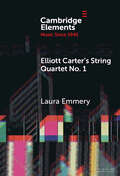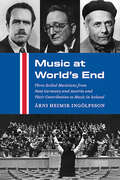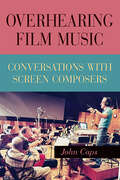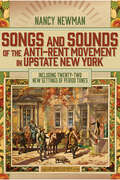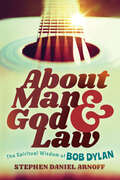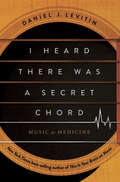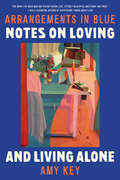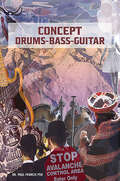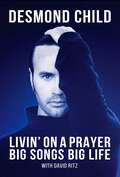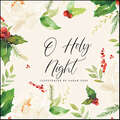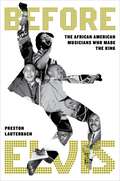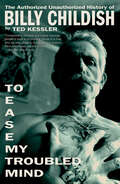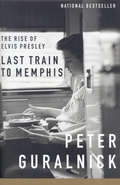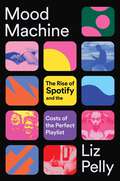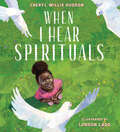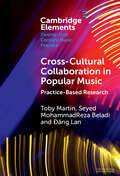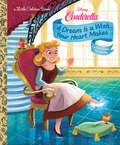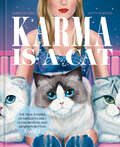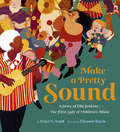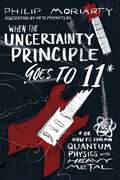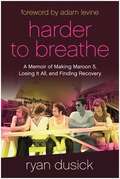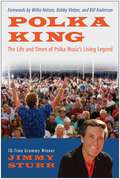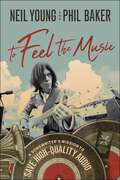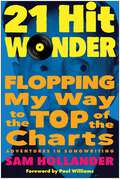- Table View
- List View
Elliott Carter's String Quartet No. 1: Myths, Narratives, and Cold War Cultural Diplomacy (Elements in Music since 1945)
by Laura EmmeryThis Element offers a critical analysis of the history of Elliott Carter's String Quartet No. 1 and the composer's rise to public acclaim, not through the study of the work itself but through intriguing and captivating narratives that surround this quartet and their socio-cultural-political context, which led Carter to become one of the most dominant voices in the post-1945 American music scene. Carter's road to success was meticulously paved by powerful institutions and individuals, including critics, scholars, festival and radio programming directors, and the US government, for whom, in the context of the Cold War, Carter was chosen to represent an exemplary American triumphant story. The author argues that it is not the quartet itself that contributed to Carter's reception and legacy, but the inextricable narratives that we associate with this work.
Music at World's End: Three Exiled Musicians from Nazi Germany and Austria and Their Contribution to Music in Iceland
by Árni Heimir IngólfssonIn Iceland in the 1930s, classical music was only beginning to be seriously practiced, at the same time when musicians of Jewish heritage were fleeing Nazi Germany and Austria. Despite the country’s strict immigration policy, three outstanding young musicians were allowed to settle there: Robert Abraham, Heinz Edelstein, and Victor Urbancic. Their influence on Iceland’s music scene as conductors, instrumentalists, teachers, and scholars proved invaluable. In Music at World's End, the first in-depth study of the lives and careers of these three musicians, musicologist Árni Ingólfsson examines their formative years in Germany and Austria, their dramatic escapes from the Nazi regime, and their triumphs and frustrating setbacks in their new homeland, a country in which Jews were virtually unknown. This fascinating case study is a valuable addition to studies of musical exile during World War II and beyond.
Overhearing Film Music: Conversations with Screen Composers (SUNY series, Horizons of Cinema)
by John CapsBeginning with a quick history of film scoring and then taking the reader backstage to interview a dozen major screen composers, Overhearing Film Music represents three generations of movie soundtrack music. Ranging from groundbreaking composers who scored classic 1940s melodramas such as Laura and the Thief of Bagdad, to the jazz-influenced modernists who worked on Rebel Without a Cause and The Pink Panther, and into the symphonic renaissance represented by films like Star Wars and Harry Potter, Caps asks the seminal questions: How did this kind of active movie scoring evolve from silent films—and where is it headed? These interviews provide a master class in how and why to score a film. Interspersed among the interviews, Caps's single-subject essays provide concise histories of the use of choral music in films, African American and female film composers, and digital composing software for a new era.
Songs and Sounds of the Anti-Rent Movement in Upstate New York: Including Twenty-Two New Settings of Period Tunes (SUNY series, An American Region: Studies in the Hudson Valley)
by Nancy NewmanUpstate New York's Anti-Rent Movement is considered the last struggle over feudalism in the United States. Tenant farmers in the Hudson-Mohawk region engaged in organized protest throughout the 1840s to contest monopoly ownership of the land they worked. Arguing their cause in newspapers, on broadsides, and at rallies, their aspirations also took shape in poetry and song. More than twenty sets of lyrics (and one instrumental composition) were written at various stages of the conflict. Some of their musical sources, such as "Old Dan Tucker" and "Bruce's Address," are still well known. Each fully contextualized song offers insight into the role vernacular music played in one of the nineteenth century’s major social reform movements.This is the first book to gather the poetry and corresponding tunes into one publication. It provides detailed analysis of the repertory, followed by new musical scores of the songs, reconstructed from contemporary historical sources for study and performance. It also examines the movement’s later dramatization in novels, film, and public commemorations as successive generations grapple with its meaning.
About Man and God and Law: The Spiritual Wisdom of Bob Dylan
by Stephen Daniel ArnoffAbout Man and God and Law is the story of how Bob Dylan sparked a revolution of the spirit and why it matters today.Many of our assumptions about empathy, sensual pleasure, and the essence of work, community, country, race, and the divine have germinated in Bob Dylan’s need to know what’s blowing in the wind and how it feels. Tracing his work and vision through themes that have shaped religious and cultural history for millennia, Stephen Daniel Arnoff uncovers how Bob Dylan has re-enchanted ancient questions of meaning and purpose throughout popular culture, inspiring a pantheon of prophetic musicians along the way. This field guide to Dylan's spiritual wisdom aims to make good on the promise that if we look closely enough at his body of work—precisely at a moment when the world we thought we knew seems like uncharted territory—we can open up our eyes to see not only where we really are, but where we need to go.
I Heard There Was a Secret Chord: Music as Medicine
by Daniel J. LevitinNATIONAL BESTSELLER One of Smithsonian's 10 Best Science Books of 2024 Neuroscientist and New York Times best-selling author of This Is Your Brain on Music Daniel J. Levitin reveals the deep connections between music and healing. Music is one of humanity’s oldest medicines. From the Far East to the Ottoman Empire, Europe to Africa and the pre-colonial Americas, many cultures have developed their own rich traditions for using sound and rhythm to ease suffering, promote healing, and calm the mind. In his latest work, neuroscientist and New York Times best-selling author Daniel J. Levitin (This Is Your Brain on Music) explores the curative powers of music, showing us how and why it is one of the most potent therapies today. He brings together, for the first time, the results of numerous studies on music and the brain, demonstrating how music can contribute to the treatment of a host of ailments, from neurodegenerative diseases such as Parkinson’s and Alzheimer’s, to cognitive injury, depression, and pain. Levitin is not your typical scientist—he is also an award-winning musician and composer, and through lively interviews with some of today’s most celebrated musicians, from Sting to Kent Nagano and Mari Kodama, he shares their observations as to why music might be an effective therapy, in addition to plumbing scientific case studies, music theory, and music history. The result is a work of dazzling ideas, cutting-edge research, and jubilant celebration. I Heard There Was a Secret Chord highlights the critical role music has played in human biology, illuminating the neuroscience of music and its profound benefits for those both young and old.
Arrangements in Blue: Notes on Loving and Living Alone
by Amy Key"[Arrangements in Blue] reflects on a life spent as a single woman and how that affects friendships, freedom, domesticity, family, sexuality, the psyche, the self. It observes things about being alone that I have never seen or heard articulated before.... beautiful, effortless.... I haven’t been so obsessed with a book in a long time." —Dolly Alderton “The poet Amy Key’s first book might be the most hyped memoir of 2023 (or at least a close second to Spare)… This raw, gorgeous, pulsing memoir is…the harbinger of a real talent.” —Laura Hackett, Sunday Times [UK] Amy Key—a writer “of rare and strange magic” (Guardian)—probes the art of living without romance in this soul-stirring debut. When British poet Amy Key was growing up, she envisioned a life shaped by love—and Joni Mitchell’s album Blue was her inspiration. “Blue became part of my language of intimacy,” she writes, recalling the dozens of times she played the record as a teen, “an intimacy of disclosure, vulnerability, unadorned feeling that I thought I’d eventually share with a romantic other.” As the years ticked by, she held on to this very specific idea of romance like a bottle of wine saved for a special occasion. But what happens when the romance we are all told will give life meaning never presents itself? Now single in her forties, Key explores the sweeping scales of romantic feeling as she has encountered them, using the album Blue as an expressive anchor: from the low notes of loss and unfulfilled desire—punctuated by sharp, discordant feelings of jealousy and regret—to the deep harmony of friendship, and the crescendos of sexual attraction and self-realization. Finding solace in Mitchell’s songs, Key plumbs Blue’s track list for themes that resonate with her heart’s seasons. Listening to the song “California,” she explores the mixed emotions that come with traveling alone in a world built for couples; she juxtaposes the lonely lyrics of “My Old Man” with the pleasurable art of curating a perfect apartment for one; and with the utmost tenderness, she parses out her decision to not have children with the eloquent “Little Green.” Mapping the evolution of her early conceptions of love through her adulthood, Key offers a tender and nakedly candid celebration of the many forms of intimacy that often go unnoticed. An essential work for both the single and the partnered, Arrangements in Blue is a bold manual for building a life on your own terms.
Concept Drums – Bass – Guitar
by Dr Paul FrancisConcept Drums - Bass - Guitar For tomorrow’s music makers This book contains: • Performance and tuition repertoire for HIGHER INSTRUMENTAL POPULAR MUSIC EDUCATION (HIPME). If you fancy a challenge, then give it a go! • CONTEMPORARY GROOVES - Stretch your technical abilities • DOWNLOADABLE BACKING TRACKS - With notated scores • EDUCATIONAL THEORY – An insight into how we learn PLUG IN.... TURN UP THE VOLUME.... 1.2.... 1...2....3....4
Livin' On A Prayer: Big Songs Big Life
by Desmond ChildDesmond Child is the ultimate hitmaker, contributing to some of the biggest smash global hits that helped ignite the success of music icons KISS, Bon Jovi, Aerosmith, Alice Cooper, Ricky Martin, Katy Perry, and countless others. In Livin' On A Prayer, he reveals how he climbed his way to the top and beyond amid extraordinary circumstances and shares his very personal and unbelievable journey that shaped him into an artist of international renown. For over half a century, Desmond Child has collaborated with the world's most celebrated artists creating timeless hits, such as Bon Jovi's Livin' On A Prayer and You Give Love A Bad Name as well as Ricky Martin's Livin' La Vida Loca and The Cup Of Life amongst his vast catalog. But in Livin' On A Prayer, Desmond himself takes center stage to share his transformational story from misfit outsider to cultural pacesetter. In collaboration with legendary music biographer David Ritz, Child recounts his unconventional upbringing as his colorful family fled Cuba in the 1960s and fell into poverty. He details his shocking discovery at age 18 that the man he called dad was not his biological father after all, and he courageously bares his soul about navigating the trials of being a Latino gay man in the macho world of rock and roll. His is a story of willing himself to succeed and overcome impossible odds to establish himself as one of the most influential composers and lyricists of all time.
O Holy Night
by Sarah CraySpread a little Yuletide cheer with Sarah Cray’s fourth book, O Holy Night. Beautiful watercolor, gouache, and ink illustrations are paired with beloved Christmas carols in this elegant hardbound volume. Allow it to serve as a charming host gift, a personal songbook, or to complement your holiday decor. The featured carols include lyrics from select stanzas of O Holy Night, Silent Night, O Little Town of Bethlehem, Hark the Herald Angels Sing, and Joy to the World—classic hymns to bring you right back to cherished moments of Christmas from years past, and to build fond new memories for Christmases yet to come.
Before Elvis: The African American Musicians Who Made the King
by Preston LauterbachIn this thought-provoking book, the Black musicians who influenced Elvis Presley's music finally receive recognition and praise. After Baz Luhrmann&’s movie, Elvis, hit theaters, audiences and critics alike couldn't help but question the Black origins of Elvis Presley&’s music and style, reigniting a debate that has been circling for decades. In Before Elvis: The African American Musicians Who Made the King, author Preston Lauterbach answers these questions definitively, based on new research and extensive, previously unpublished interviews with the artists who blazed the way and the people who knew them. Within these pages, Lauterbach examines the lives, music, legacies, and interactions with Elvis Presley of the four innovative Black artists who created a style that would come to be known as Rock &’n&’ Roll: Little Junior Parker, Big Mama Thornton, Arthur &“Big Boy&” Crudup, and mostly-unknown eccentric Beale Street guitarist Calvin Newborn. Along the way, he delves into the injustices of copyright theft and media segregation that resulted in Black artists living in poverty as white performers, managers, and producers reaped the lucrative rewards. In the wake of continuing conversations about American music and appropriation, Before Elvis is indispensable.
To Ease My Troubled Mind: The Authorized Unauthorized History of Billy Childish
by Ted KesslerThe story of Billy Childish, the most famous artist you’ve never heard of, by legendary music journalist Ted Kessler In 1977, seventeen-year-old Steven Hamper was a stonemason in the dockyards of Chatham, Kent, in England. His heart, however, beat in sync with the punk rock tremors of the era, seduced by its celebration of amateurism. So, in a gesture of revolutionary defiance, he took a three pound club hammer and smashed his hand, vowing to never work again. In doing so, Steven Hamper metamorphosed into Billy Childish, a true Renaissance man. Childish has since remained steadfastly true to punk’s DIY cred, becoming one of the most recognizable and authentic voices in whichever artistic endeavor he undertakes. He has released over 150 albums of raw rock and roll, punk, blues, and folk; and has written many volumes of searing poetry as well as several autobiographical novels. But what he is perhaps best known for in recent years is his painting, for which he is now critically, commercially, and internationally feted. He hasn’t changed course in any of his disciplines, though. The world just caught up with the sheer volume of his brutally honest work. To Ease My Troubled Mind is a mosaic portrait collated over a year of interviews with Childish, as well as with close family, ex-girlfriends, band members past and present, friends, foes, collaborators, even his therapist. It is an unflinching, yet frequently spiritual and funny portrait of an artist who is now one of the most prolific and uncompromising of his generation. The volume also includes a foreword by British comedian Stewart Lee.
Last Train to Memphis: The Rise of Elvis Presley
by Peter GuralnickWritten with grace, humor, and affection, Last Train to Memphis has been hailed as the definitive biography of Elvis Presley. It is the first to set aside the myths and focus on Elvis' humanity in a way that has yet to be duplicated.A New York Times Notable BookWinner of the Ralph J. Gleason Music Book Award"Elvis steps from the pages. You can feel him breathe. This book cancels out all others." --Bob Dylan From the moment that he first shook up the world in the mid 1950s, Elvis Presley has been one of the most vivid and enduring myths of American culture.Last Train to Memphis: The Rise of Elvis Presley is the first biography to go past that myth and present an Elvis beyond the legend. Based on hundreds of interviews and nearly a decade of research, it traces the evolution not just of the man but of the music and of the culture he left utterly transformed, creating a completely fresh portrait of Elvis and his world.This volume tracks the first twenty-four years of Elvis' life, covering his childhood, the stunning first recordings at Sun Records ("That's All Right," "Mystery Train"), and the early RCA hits ("Heartbreak Hotel," "Hound Dog," "Don't Be Cruel"). These were the years of his improbable self-invention and unprecedented triumphs, when it seemed that everything that Elvis tried succeeded wildly. There was scarcely a cloud in sight through this period until, in 1958, he was drafted into the army and his mother died shortly thereafter. The book closes on that somber and poignant note.Last Train to Memphis takes us deep inside Elvis' life, exploring his lifelong passion for music of every sort (from blues and gospel to Bing Crosby and Mario Lanza), his compelling affection for his family, and his intimate relationships with girlfriends, mentors, band members, professional associates, and friends. It shows us the loneliness, the trustfulness, the voracious appetite for experience, and above all the unshakable, almost mystical faith that Elvis had in himself and his music. Drawing frequently on Elvis' own words and on the recollections of those closest to him, the book offers an emotional, complex portrait of young Elvis Presley with a depth and dimension that for the first time allow his extraordinary accomplishments to ring true.Peter Guralnick has given us a previously unseen world, a rich panoply of people and events that illuminate an achievement, a place, and a time as never revealed before.
Mood Machine: The Rise of Spotify and the Costs of the Perfect Playlist
by Liz PellyAn unsparing investigation into Spotify&’s origins and influence on music, weaving unprecedented reporting with incisive cultural criticism, illuminating how streaming is reshaping music for listeners and artists alike.Drawing on over one hundred interviews with industry insiders, former Spotify employees, and musicians, Mood Machine takes us to the inner workings of today&’s highly consolidated record business, showing what has changed as music has become increasingly playlisted, personalized, and autoplayed. Building on her years of wide-ranging reporting on streaming, music journalist Liz Pelly details the consequences of the Spotify model by examining both sides of what the company calls its two-sided marketplace: the listeners who pay with their dollars and data, and the musicians who provide the material powering it all. The music business is notoriously opaque, but here Pelly lifts the veil on major stories like streaming services filling popular playlists with low-cost stock music and the rise of new payola-like practices. For all of the inequities exacerbated by streaming, Pelly also finds hope in chronicling the artist-led fight for better models, pointing toward what must be done collectively to revalue music and create sustainable systems. A timely exploration of a company that has become synonymous with music, Mood Machine will change the way you think about and listen to music.
When I Hear Spirituals
by Cheryl Willis HudsonYour spirit will soar! A girl connects with heritage, history, and a higher power through the lyrics of twelve beloved spirituals and four seminal events in African American history. A beautiful keepsake to be shared by multiple generations.When I hear spirituals Sometimes A big, full feelingGrows in my chest . . . Her heart pounds, she gets a lump in her throat, and tears flow down her cheeks. She wants to clap her hands and stomp her feet. There is healing, tenderness, strength, pride, and above all, hope.The author of the classic picture book Bright Eyes, Brown Skin, Cheryl Willis Hudson, has woven together lyrics of twelve timeless, Black spirituals with a moving exploration of how music holds memories, emotions, and empowerment.Songs include &“Go down, Moses,&” &“Nobody Knows the Troubles I See,&” &“Sometimes I Feel Like a Motherless Child,&” &“Rock-a-My Soul,&” &“Get on Board, Little Children,&” and more. Evocative illustrations by award-winning artist London Ladd depict important people and places in Black history and culture: Harriet Tubman, Martin Luther King, Jr., the Great Migration, and the Enslaved People&’s Uprising of 1811. Journey through Black history and music in this layered picture book.A Junior Library Guild Gold Standard Selection
Cross-Cultural Collaboration in Popular Music: Practice-Based Research (Elements in Twenty-First Century Music Practice)
by Toby Martin Seyed Mohammadreza Beladi Dang LanCross-cultural collaboration in popular music represents opportunities for the audibility of multiple voices and the creation of new sounds, but it also presents many challenges. These challenges are both musical – that is, how to technically match voices – and ethical – that is, how to negotiate historically entrenched power discrepancies. Practice-based research has recently developed as a field in popular music studies. This burgeoning area has much to offer in terms of new knowledge, based on embodied insights, lived experience, and an arts practice. Through a practitioner-centred account of three projects involving traditional Persian and Vietnamese musicians, and western folk/rock musicians, the Element suggests pragmatic strategies and conceptual frameworks for making pop music with people of different cultural backgrounds.
A Dream Is a Wish Your Heart Makes (Little Golden Book)
by Golden BooksSing and dream along with Princess Cinderella in this beautiful Little Golden Book featuring the lyrics to &“A Dream is a Wish Your Heart Makes&”!Princess Cinderella has big dreams in her heart, and she&’s determined to make them come true! This beautifully illustrated Little Golden Book featuring the lyrics to the beloved song &“A Dream is a Wish Your Heart Makes&” and scenes from Disney&’s Cinderella is sure to be a treasure for children ages 2 to 5 as well as Little Golden Book collectors and Disney fans of all ages.Check out these other Disney lyrics Little Golden Books:Do You Want to Build a Snowman? (Disney Frozen)Part of Your World (Disney The Little Mermaid)Circle of Life (Disney The Lion King)Little Golden Books enjoy nearly 100% consumer recognition. They feature beloved classics, hot licenses, and new original stories. . . the classics of tomorrow.
Karma Is a Cat: The True Stories of Meredith Grey, Olivia Benson, and Benjamin Button Swift
by Farrin JacobsThe first book featuring the true story of the loves of Taylor Swift&’s life: her cats! Meredith Grey, Olivia Benson, and Benjamin Button are much more than footnotes in the story of Taylor Swift&’s life. They&’re in her music videos and ads, they&’re on magazine covers with her and all over her social media, and they even travel with her when she goes on tour. With adorable, full-color art, Karma Is a Cat is the first book to feature their inspawring stories. Discover the facts behind the fur and find all kinds of hidden messages in this purrfect read for Taylor Swift fans and cat lovers of all ages! In these pages, you&’ll find: • The story of their adoptions• Fun facts about their breeds and personalities• Adorable illustrations of events in their lives• And so much meowre! Get to know these feline siblings as they experience life with one of the biggest superstars on the planet!
Make a Pretty Sound: A Story of Ella Jenkins—The First Lady of Children's Music
by Traci N. ToddOnce upon a time, children's music was just Mother Goose, nursery songs, and lullabies. And then came Ella Jenkins.Ella Jenkins is an American folk singer and living legend dubbed "The First Lady of Children’s Music." For nearly 70 years, she has been writing and performing music that has entertained and engaged generations of young listeners. In Make a Pretty Sound, Ella’s life and legacy are captured in vibrant sights, sounds, and stories that leap right off the page. Born in St. Louis, Missouri, and raised in Chicago, Ella grew up loving music of all kinds—the call-and-response of Cab Calloway, the exciting rhythms of Moroccan and Indian records spun in a local record shop, the bluesy notes her uncle teased from his harmonica. She listened to music from around the world, and no matter what language it was in, she could feel what it meant—the bridge in understanding and feeling that music offers from one heart to another. When she began working with children, she knew just what to do. She knew music would offer children a kinetic learning experience that engaged them physically, verbally, and empathetically, creating community out of song. Soon, she was recording her own albums and became an international star. In these beautifully illustrated pages, Ella’s journey—from the gritty streets of Chicago to the classrooms where she found her calling to an opportunity to raise her voice for freedom alongside Martin Luther King, Jr., to the spotlight of the world’s stage—is rhythmically, joyfully, brilliantly illuminated. For readers familiar with Ella Jenkins or new to her work, this nonfiction picture book offers a treasury of inspiration that touches on American history, civil rights, cultural awareness, and the incredible power of music.A LIVING LEGEND: Drawing on personal interviews the author conducted with Ella and her manager, this is Ella’s story told in her own words. For all who have felt the impact of her work in children's programming, in classrooms, and in their homes, this is a wonderful opportunity to explore the legacy of an artist who offers children the gift of music and the gift of knowing that another human heart reaches out to theirs. LYRICAL TEXT AND ART: Rhythmic text and colorful illustrations celebrate the musicality of Ella's life and convey the singular joy that is found in the sharing of music! BEAUTIFUL GIFT BOOK: With extraordinary writing and beautiful art, this book makes a perfect present for any young reader who loves music, biographies, or both.Perfect for: Fans of Ella Jenkins Parents, teachers, and caregivers of children who love music Teachers and librarians looking for a great picture book biography Anyone interested in multicultural music for kids Readers who enjoy the Little People, BIG DREAMS and Who Is/Who Was biography series Gift givers looking for a children’s music book for birthday, holiday, or any celebratory occasion
Through the Eye of the Tiger: The Rock n' Roll Life of Survivor's Founding Member
by Jim Peterik Lisa Torem"Hey, yo, Jim . . . This is Sylvester Stallone. Give me a call . . ." It was these words that would set Jim Peterik on the road to rock 'n' roll immortality. After he and his Survivor bandmates recorded "Eye of the Tiger" for the Rocky III soundtrack, the song would go on to earn a Grammy, an Oscar nomination, reach triple platinum status—and become one of the most recognizable tunes in music history. But there's much more to the story of Survivor and its founding member, Jim Peterik, than meets the eye. As one of the most prolific songwriters of his generation, Peterik has cowritten songs with some of the most famous bands and artists of our time, including 38 Special ("Caught Up in You," "Hold on Loosely"), Sammy Hagar ("Heavy Metal"), The Beach Boys, The Doobie Brothers, REO Speedwagon, Cheap Trick, and many more. Now, for the first time, Peterik is sharing his stories. Filled with tales from Peterik's life in rock 'n' roll, Through the Eye of the Tiger documents his early days of success with The Ides of March ("Vehicle"), through the often torturous power struggles within Survivor, and the giddy highs that accompany a trail of worldwide hits. From going to a party in Led Zeppelin's hotel room (and turning right back out the door) to escorting a disoriented Janis Joplin back to her hotel room after opening her show in Calgary, Peterik's accounts will surprise and delight. Through the Eye of the Tiger is more than just a memoir of a songwriting legend; it's a classic rock 'n' roll story told through the eyes of someone who has lived through it all—and through the Eye of the Tiger.
When the Uncertainty Principle Goes to 11: Or How to Explain Quantum Physics with Heavy Metal
by Philip MoriartyThere are deep and fascinating links between heavy metal and quantum physics. No, really! While teaching at the University of Nottingham, physicist Philip Moriarty noticed something odd, a surprising number of his students were heavily into metal music. Colleagues, too: a Venn diagram of physicists and metal fans would show a shocking amount of overlap. What's more, it turns out that heavy metal music is uniquely well-suited to explaining quantum principles. In When the Uncertainty Principle Goes to Eleven, Moriarty explains the mysteries of the universe's inner workings via drum beats and feedback: You'll discover how the Heisenberg uncertainty principle comes into play with every chugging guitar riff, what wave interference has to do with Iron Maiden, and why metalheads in mosh pits behave just like molecules in a gas. If you're a metal fan trying to grasp the complexities of quantum physics, a quantum physicist baffled by heavy metal, or just someone who'd like to know how the fundamental science underpinning our world connects to rock music, this book will take you, in the words of Pantera, to "A New Level." For those who think quantum physics is too mind-bendingly complex to grasp, or too focused on the invisibly small to be relevant to our full-sized lives, this funny, fascinating book will show you that physics is all around us . . . and it rocks.
Harder to Breathe: A Memoir of Making Maroon 5, Losing It All, and Finding Recovery
by Ryan DusickTwo decades after Songs About Jane, Maroon 5&’s original drummer presents an unflinching examination of fame, anxiety, mental health, and recovery In the nineties, Ryan Dusick and his friends Adam Levine and Jesse Carmichael dreamed about making it big . . . and against all odds, they did. This inside story recounts Maroon 5&’s founding and their road to becoming Grammy-winning megastars, told through the eyes of former drummer Ryan Dusick. He takes readers behind the scenes of the band&’s meteoric rise to success—and the grueling demands that came with it—as well as his personal struggles with anxiety and addiction after his departure from the band. For Maroon 5, fame came with a platinum debut record, jam sessions with Prince in his own living room, and encounters with celebrities such as Jessica Simpson, Justin Timberlake, John Mayer, and Bono. For Dusick, stardom came to an abrupt halt with the devastating loss of his ability to play drums due to chronic nerve damage. Alongside Maroon 5&’s story of camaraderie and pressure, Dusick interweaves his own narrative: a decade lost to liquor and antianxiety medication, his ferocious commitment to recovery, and his current perspective as a professional counselor. With a candor that will speak to anyone who has struggled with mental health, Harder to Breathe moves beyond celebrity to examine the nature of human heartbreak and resilience, and to buoy anyone currently facing similar challenges. Ultimately, Harder to Breathe is a roller-coaster memoir about how making it to the top sent Dusick to the bottom—and how he let go of the past and embraced a new future, one breath at a time.
Polka King: The Life and Times of Polka Music's Living Legend
by Jimmy SturrArguably the most important polka practitioner of his generation, reedist/vocalist Jimmy Sturr has won an eye-popping 18 Grammy Awards, and when you hear his exuberant brand of the music that is his heart and soul, you'll understand why. Blending the timeless elements of traditional polka music with hints of country, Cajun, and rock and roll, Sturr's unique sound has taken polka to new heights of accessibility and popularity, and his modernized renditions of polka standards and renditions of rock classics have captured the imagination (and feet) of listeners throughout the world. In his memoir Polka King, you'll meet the man behind the beer barrel. In his lively, oftentimes hilarious literary debut, Jimmy chronicles how a small-town boy from tiny Florida, N.Y., made good, ultimately becoming a respected bandleader, entrepreneur, and Grammy winner with guest appearances on Saturday Night Live. He'll take you into the recording studio and onto the stage, where he's shared the microphone with the likes of Willie Nelson, The Oak Ridge Boys, and Charlie Daniels. Featuring forewords by Willie Nelson, Bobby Vinton, and &“Whispering" Bill Anderson, Polka King will introduce the world to a one-of-a-kind artist who has taken one of the world's most beloved musical genres and made it his own.
To Feel the Music: A Songwriter's Mission to Save High-Quality Audio
by Neil Young Phil BakerNeil Young took on the music industry so that fans could hear his music—all music—the way it was meant to be heard. Today, most of the music we hear is com-pressed to a fraction of its original sound,while analog masterpieces are turning to dustin record company vaults. As these record-ings disappear, music fans aren't just losing acollection of notes. We're losing spaciousness,breadth of the sound field, and the ability tohear and feel a ping of a triangle or a pluckof a guitar string, each with its own reso-nance and harmonics that slowly trail off intosilence. The result is music that is robbed of its original quality—muddy and flat in sound compared to the rich, warm sound artists hear in the studio. It doesn't have to be this way, but the record and technology companies have incorrectly assumed that most listeners are satisfied with these low-quality tracks. Neil Young is challenging the assault on audio quality—and working to free music lovers from the flat and lifeless status quo. To Feel the Music is the true story of his questto bring high-quality audio back to musiclovers—the most important undertaking ofhis career. It's an unprecedented look insidethe successes and setbacks of creating thePono player, the fights and negotiationswith record companies to preserve master-pieces for the future, and Neil's unrelentingdetermination to make musical art availableto everyone. It's a story that shows how muchmore there is to music than meets the ear. Neil's efforts to bring quality audio to his fans garnered media attention when his Kickstarter campaign for his Pono player—a revolutionary music player that would combine the highest quality possible with the portability, simplicity and affordability modern listeners crave—became the third-most successful Kickstarter campaign in the website's history. It had raised more than $6M in pledges in 40 days. Encouraged by the enthusiastic response, Neil still had a long road ahead, and his Pono music player would not have the commercial success he'd imagined. But he remained committed to his mission, and faced with the rise of streaming services that used even lower quality audio, he was determined to rise to the challenge. An eye-opening read for all fans of Neil Young and all fans of great music, as well as readers interesting in going behind the scenes of product creation, To Feel the Music has an inspiring story at its heart: One determined artist with a groundbreaking vision and the absolute refusal to give up, despite setbacks, naysayers, and skeptics.
21-Hit Wonder: Flopping My Way to the Top of the Charts
by Sam HollanderRising up the charts seemed, at many points in Sam Hollander&’s career, highly unlikely. This is his story of failing his way to the top. As one of the most renowned, multi-platinum songwriters and producers in the game, Sam Hollander has written and produced for the likes of Panic! At The Disco, One Direction, Katy Perry, Ringo Starr, Def Leppard, Carole King, Weezer, blink-182, Jewel, Train, Fitz and the Tantrums, Billy Idol, Tom Morello, and many others. But before he was stacking Billboard hits, Hollander was piling up calamitous flops, false starts, and feeling like the world was moving on and up without him while he spun in place. Today he wears that decade of misses like a badge of honor. In 21-Hit Wonder, he&’s collected anecdotes from his wild music industry rollercoaster ride to help aspiring songwriters and other creatives learn about survival, endurance, scheming, hustle, and the importance of laughing even on the worst days of the journey. Music lovers spanning generations and genres will find stories about many of their heroes and industry icons. 21-Hit Wonder is one part chronicle of a songwriter&’s storied career and another part love letter to anyone who has been counted out—from no-hit wonders and one-hit wonders to the novelties and the never-beens—and just needs a bit of inspiration to persevere. Sam&’s inspiring story is proof that setbacks are just steps on the road to success.
